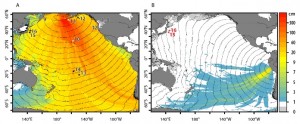1586: Year of the “Orphan Tsunami”
December 25, 2017
Newly published evidence from Makauwahi Cave suggests that we may now know precisely which mega-tsunami hit here over four centuries ago and left tell-tale deposits.
In the journal Natural Hazards we published an article recently entitled “The Orphan Sanriku Tsunami of 1586: New evidence from Coral Dating on Kaua`i.” Although radiocarbon dating had previously pinpointed the evidence for some sort of “extreme event” at the cave to within about a century, we used fresh-looking pieces of coral embedded in the tsunami deposit inside the cave to date the event using a high-resolution Uranium-series technique that may be accurate to within just a couple of decades.

Scientists ran computer simulations of the two earthquakes inferred to have happened in 1586; a 9.25 earthquake in the Eastern Aleutians (left) and an 8.05 in Peru (right). Predicted tsunami heights for the Sanriku orphan tsunami in Japan matched the Aleutian model much better.
Scanning the historical literature from Japan to Latin America for tsunami events in this narrower period, we arrived at the conclusion that a tsunami recorded in Sanriku, Japan in 1586 fit the bill best (and much better than one in Peru the same year).
What is an “orphan tsunami?” This is one that arrives on a beach with no earthquake to provide forewarning. Our modeled tsunami, published a few years ago in the journal Geophysical Research Letters, predicted that a 9+ earthquake in the eastern Aleutian Islands would have been the most likely source for whatever giant wave or waves engulfed Makauwahi Cave, raining down a yard-thick layer of stones, gravel, sand – and precisely dateable coral broken from the adjacent reef.
Of course, the question that always arises is “will there be another one?” Dr. Rhett Butler, lead author on both papers, pointed out in a recent interview that another “big one” is likely to occur, but we can’t know exactly when. Some statistical modeling suggests that a tsunami of this magnitude could happen again any time now – see the interview here. “Hawaii is surrounded by the ‘ring of fire’ where mega-earthquakes generate great tsunamis impacting our island shores—the 2011 Tohoku Japan is the most recent example,” said Butler. “Even though there was no seismic instrumentation in the 16th century, we offer a preponderance of evidence for the occurrence of a magnitude 9 earthquake in the Aleutian Islands. Our knowledge of past events helps us to forecast tsunami effects and thereby enables us to assess this risk for Hawaii.”
Our forecast models of a great Aleutian event has informed the development of new maps of extreme tsunami inundation zones for the State of Hawai‘i. By linking evidence from Makauwahi Cave to other sites around the Pacific, we can better understand the Aleutian earthquake that may have generated the tsunami, and develop evacuation routes for mega-tsunamis that could save thousands of lives.
Comments:
David Burney on December 26, 2017
Aurele, So good to hear from you, and Happy New Year! We hope to get back to wonderful Rodrigues sometime -- Francois Leguat Giant Tortoise and Cave Reserve is a great inspiration to people everywhere in the world who are interested in progressive ideas in conservation. Also hope to see you sometime at Makauwahi Cave Reserve!
Aurele A. Andre on December 25, 2017
Thank you for interesting article and greetings from the Francois Leguat Giant Tortoise and Cave Reserve, Anse Quitor, Rodrigues Island, Indian ocean